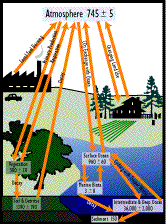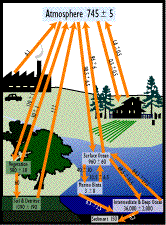


The movement of carbon, in its many forms, between the
biosphere, atmosphere, oceans, and geosphere is described by the carbon cycle, illustrated
in the adjacent diagram. The carbon cycle is one of the biogeochemical
cycles. In the cycle there are various sinks, or stores, of carbon (represented by the
boxes) and processes by which the various sinks exchange carbon (the arrows).
We are all familiar with how the atmosphere and vegetation exchange carbon. Plants absorb CO2 from the atmosphere during photosynthesis, also called primary production, and release CO2 back in to the atmosphere during respiration. Another major exchange of CO2 occurs between the oceans and the atmosphere. The dissolved CO2 in the oceans is used by marine biota in photosynthesis.
Two other important processes are fossil fuel burning and changing land use. In fossil fuel burning, coal, oil, natural gas, and gasoline are consumed by industry, power plants, and automobiles. Notice that the arrow goes only one way: from industry to the atmosphere. Changing land use is a broad term which encompasses a host of essentially human activities. They include agriculture, deforestation, and reforestation.

The carbon cycle is obviously very complex, and each process has an impact on the other processes. If primary production drops, then decay to the soil drops. But does this mean that decay from the soil to the atmosphere will also drop and thus balance out the cycle so that the store of carbon in the atmosphere will remain constant? Not necessarily; it could continue at its current rate for a number of years, and thus the atmosphere would have to absorb the excess carbon being released from the soil. But this increase of atmospheric carbon (in the form of CO2) may stimulate the ocean to increase its uptake of CO2 .
What is known is that the carbon cycle must be a closed system; in other words, there is a fixed amount of carbon in the world and it must be somewhere. Scientists are actively investigating the carbon cycle to see if their data does indeed indicate a balancing of the cycle. These types of investigations have led many scientists to believe that the forests of the Northern Hemisphere are, in fact, absorbing 3.5 Gt C per year, and so changing land use is actually removing carbon from the atmosphere (~2 Gt C/year), not increasing it as the diagram shows. Experiments are ongoing to confirm this information.
|
[ Glossary] [ Related Links ] [ References ] [ PBL Model ] [ Home ] [ Teacher Pages ] [ Modules & Activities ] |
HTML code by Chris Kreger
Maintained by ETE Team
Last updated November 10, 2004
Some images © 2004 www.clipart.com
Privacy Statement and Copyright © 1997-2004 by Wheeling Jesuit University/NASA-supported Classroom of the Future. All rights reserved.
Center for Educational Technologies, Circuit Board/Apple graphic logo, and COTF Classroom of the Future logo are registered trademarks of Wheeling Jesuit University.